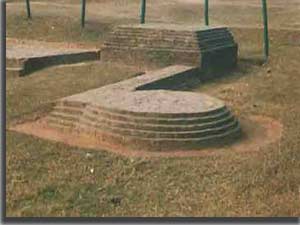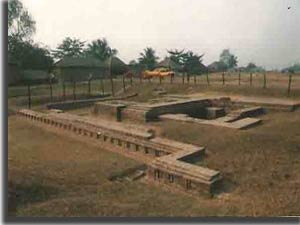History :
Shashanka was the first important king of ancient Bengal, who occupied a prominent place in Indian history. It was generally believed that Shashanka ruled approximately between 600 CE and 625 CE, and two dated inscriptions, issued in his 8th and 10th ruling years from Midnapore, and another undated inscription from Egra near Kharagpur have been discovered. The copper plate from Shashanka's subordinate king of Ganjam (Odissi) Madhavavarma, Harshavardhana's Banskhera and Madhuvan copper plates and the Nidhanpur copper plate of the Kamarupa king Bhaskaravarman contain information about Shashanka.
King Shashanka also issued gold and silver coins. Between the decline of Guptas and the rise of Shashanka, a number of independent rulers flourished in Bengal in the intervening period and their existence is known from a few inscriptions and gold coins. The seal-matrix of Shri Mahasamanta Shashanka from Rohtasgarh, the contemporary literary accounts of Banabhatta and the Chinese pilgrim Xuanzang (also known as Hiuen Tsang) as well as the Buddhist text Aryamanjushrimulakalpa are important sources of information on him. In the inscriptions and literary accounts also Shashanka is described as the ruler of Gauda. In the narrower sense Gauda is the territory between the river Padma and Bardhaman region, however in course of time it embraced much wider area.
Extending political influence
The ruler Shashanka first established himself in Gauda, the north-western region of Bengal, and made Kornosubora in Murshidabad his capital. Then he gradually extended his rule in Odissi, parts of Central Provinces as well as in Bihar, though his attempts to establish his authority further north lasted for only a short period. The contribution of Shashanka in the history of Bengal was that he defended the independence of the Gauda empire against a very powerful northern Indian adversary, Harsavardhana which became very important in Indian history. For a king of Bengal, it was a great show of strength to have ventured into northern Indian politics. So he can be seen as the first important king of Bengal, who for the first time brought her into competition with other states for control of northern India. In this sense, he was the forerunner of the aggressive northern Indian policy of the later Pala rulers such as Dharmapala and Devapala.
Art & Architecture of Shashanka Dynasty

Ruins of Shashanka's citadel were also excavated. The other structures unearthed include the base of several square and circular stupas, remains of square rooms (probably classrooms or rooms where the students put up), remnants of two walls (possibly the boundary of the capital) and a well (which might have been built later). The ruins were declared a site of national importance.

Although declared a site of national importance, the ruins lie in utter neglect. But there are the remains of a temple and part of the Buddhist vihar, scattered over a wide expanse, to be seen. And they do give you a feel of historical nostalgia.
Shashanka, the controversial Bengali monarch who ruled over the kingdom of Gaur from 600 to 638 and checked the eastward march of the imperial armies of Gupta king Harshavardhana, had his capital here. Karnasubarna is now home to the ruins of the ancient Buddhist university of Raktamrittika.
Place |
West Bengal |
Period |
600-625 |


